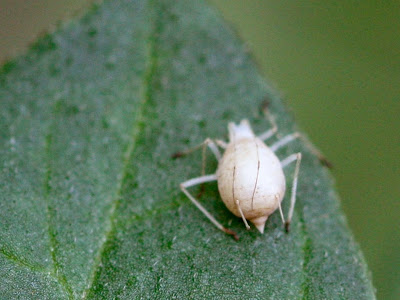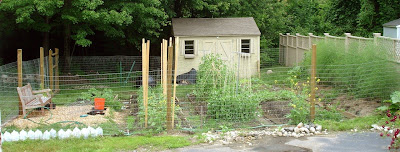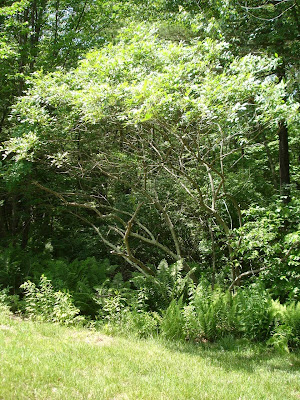
I went for a walk today at
Stony Brook Wildlife Sanctuary.

I had assumed this was a native plant until I looked it up at the website of the
Connecticut Botanical Society, which has flowers listed by color. Their site is a fantastic tool for identifying flowers of New England, and this particular flower is a dissapointment. It's celandine,
chilidonium majus, a plant of European origin. Too bad, because I had recently spotted some in my yard.

This is Swamp Azalea,
rhododendron viscosum, a glorious native. I suspect some of the shrubs in my back yard are this plant, but if they are, they aren't giving themselves away with any flowers just yet.
An interesting feature of this plant is that the outsides of this plant are covered with tiny sticky balls that trap insects. Why do they do this? I don't know. They aren't carnivorous.

Finally I have seen this plant in flower! I was unable to identify it until I saw the bloom. It is pickerelweed,
pontderia cordata. Native!

This is one native I was already familiar with: common milkweed,
asclepias syriaca. I don't know why roses and mums get such attention when there is beauty such as this in the world.

It delights me that something so exotic-looking is native: fragrant water-lily,
nyphaea odorata. There were dozens of turtles lazing on logs among these flowers today, surprisingly unphazed by various noisy children.

Ah, so this is forget-me-not,
myosotis scorpioides. It is on the
Massachusetts Prohibited Plant List. It is also in my back yard. So sad, I must kill it.

Wow! This stuff that looks like orange silly-string was the highlight of my trip: common dodder,
cuscuta gronovii. I had only seen it in photos until today. This is the vampire of New England native plants. Shortly afer springing from its seed, it latches onto a host plant, from which it sucks nutrients. Once established on the host, it says goodbye to the ground.

Gabe is going to love this place when he gets older.
 Last year I didn't know what these large round and white aphids were. I thought that they might be aphids that were transforming into the flying variety and naively I removed them. They are aphids that have been parasitized by wasps. The wasps lay eggs in them and the wasp larva eventually come out to parasitize more aphids. Now that the wasps are out and active I've found I haven't had to work to control the aphids anymore as the large flying aphids are getting picked off before they can multiply. The short message is don't squish these!
Last year I didn't know what these large round and white aphids were. I thought that they might be aphids that were transforming into the flying variety and naively I removed them. They are aphids that have been parasitized by wasps. The wasps lay eggs in them and the wasp larva eventually come out to parasitize more aphids. Now that the wasps are out and active I've found I haven't had to work to control the aphids anymore as the large flying aphids are getting picked off before they can multiply. The short message is don't squish these!

























































